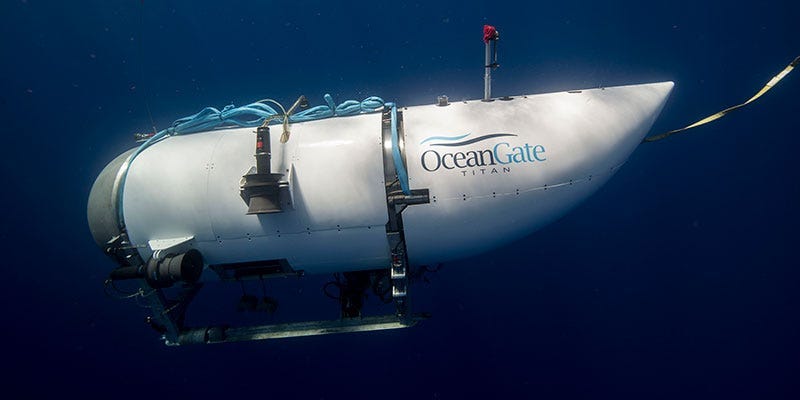A writer who said he was set to travel on the doomed Titan submersible said OceanGate CEO Stockton Rush told him that for the vessel's hull, the company used cut-price Boeing carbon fiber that was past its airplane shelf life.
The stunning claim came in a series of articles by Travel Weekly's editor in chief, Arnie Weissmann, who this week chronicled his experiences with the deep-sea-diving company.
Weissmann wrote that he was due to board the Titan to view the Titanic in May but the trip was stopped by weather. In fact, just a couple of weeks stood between his would-be voyage and the trip that ended in tragedy this week when the vessel imploded, killing all five on board, he wrote.
In general, he said, he was impressed by "what appeared to be a risk-averse operation."
But one thing concerned him, he wrote.
Rush told Weissmann that "he had gotten the carbon fiber used to make the Titan at a big discount from Boeing because it was past its shelf life for use in airplanes," Weissmann wrote.
In his recollection, he asked Rush whether that was a problem, but he said he was told that the shelf-life dates "were set far before they had to be."
Both OceanGate and Boeing declined to comment on Weissmann's claims. Insider was unable to independently verify the source of the Titan's carbon fiber.
OceanGate's website previously claimed that the vessel was designed and engineered "in collaboration" with Boeing.
Boeing has denied any involvement in the design of the Titan.
Much remains unknown about the circumstances of the disaster, including what could have caused the vessel to implode. The US Coast Guard said Thursday that debris found at the scene was "consistent with catastrophic loss of the pressure chamber."
The Titan's experimental carbon-fiber hull has become a subject of discussion since the vessel went missing.
Rush previously touted the cost-saving benefits of carbon fiber versus the standard titanium and claimed in a 2021 presentation that "carbon fiber is three times better on a strength-to-buoyancy basis than titanium."
"And underwater, that's what you care about," he added.
A 2017 CompositesWorld report said the initial carbon-fiber hull design was prepared on just a six-week deadline, though GeekWire reported the vessel was rebuilt later.
Before the tragic trip, Rush publicly discussed taking risks to pursue what he called "innovation," saying in 2021 that he knew he had "broken some rules" by using a carbon-fiber hull for the vessel.



"How many atmospheres of pressure can it take?"
It's amazing to me that people do stuff like go down miles in the ocean but they don't google the company in question. If there's a magic phrase like "You can see the Titanic up close! It will be just feet away!" - their critical thinking skills turn off.
It doesn't help that the legit sub company is called Triton. So when people who don't do any real research see "Titan" they're like oh yeah! The guys who make good luxury submarines!
I wonder how much google would have turned up before this? I doubt there would have been much on it besides official company media.
If you can't find anything about a company that's going to send you 4,000m down into a depth that will kill you due to even a tiny slip up - that's not a trip any sane, rational, intelligent person is going to make. If I had $250,000 to spend on a trip - I'd splurge on a private jet and go on a killer vacation to a place like the Great Bear Rainforest for a week. I don't know what that would cost. ~$10k? Anyway - I'll still have ~$240k.
But people that are willing to risk death to see the Titanic aren't anything like me.
A brain genius stridently disagrees with me - https://hexbear.net/post/274700